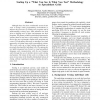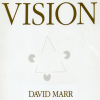784 search results - page 12 / 157 » What would they think |
ECAI
1998
Springer
13 years 12 months ago
1998
Springer
Many kinds of knowledge-based system would be easier to develop and maintain if domain experts (as opposed to knowledge engineers) were in a position to define and edit the knowled...
VL
1999
IEEE
13 years 12 months ago
1999
IEEE
Although there has been considerable research into ways to design visual programming environments to improve the processes of creating new programs and of understanding existing o...
ICSE
1998
IEEE-ACM
13 years 12 months ago
1998
IEEE-ACM
Form-based visual programming languages, which include commercial spreadsheets and various research systems, have had a substantial impact on end-user computing. Research shows, h...
Book
"What does it mean, to see? The plain man's answer (and Aristotle's, too) would be, to know what is where by looking. In other words, vision is the process of discov...
ADAEUROPE
2010
Springer
14 years 14 days ago
2010
Springer
Now that multicore microprocessors have become a commodity, it is natural to think about employing them in all kinds of computing, including high-reliability embedded real-time sy...


